I am happy to announce that sacred art is back in style and if, in 200 years or so, Western civilization has been saved, we can add Christopher Nolan to the list of people to thank. Why? Because thanks to his art, the Gospel is again being preached – and to more people, perhaps, than we have been reaching with our more overt means. He has done, with his work, what every evangelist ought to do: communicate the salvific Christian message in the mode of the receiver. In this case, the receiver is the movie goer – so, everybody who is watching his movies and, thanks be to God, there are a lot of people watching his movies. Frankly, the main reason I am writing this piece is because I am tired of Catholic movie reviewers who simply do not seem to have ears to hear. “What exactly is Christian about the work of Nolan?” many ask. “You want a Christian movie, go rent Fire Proof or For Greater Glory- right?” Wrong. Those movies are good and helpful, but they are preaching to the choir for the most part. Nolan’s Batman trilogy not only features Christian Bale – but Christian Allegory. I will bring the reader back to Inception which illustrates the heart of Nolan’s motivation: to be awakened and brought into reality, one requires a “kick.” There is no better kick than beauty – portrayed in Inception through the music of Edith Piaf, it is this kick that can elevate the soul and recollect one to the world beyond the illusory shades.

Though not the work of Nolan, this point was also illustrated wonderfully in the Hunger Games. The whistle of the bird is the only thing that can communicate the message of salvation – precisely because it blends in to the scenery; it is heard only by those who have ears to hear. The message must be masked. Incidentally, the mask is exactly what Batman tells John Blake aka Robin that he must wear if he is going to be in this fight. Did you notice that? The faithful disciple, who is also the one who heralds Batman’s return, is named John – and John’s symbol is a…bird. Sound familiar? Coincidence? Remember, if you are going to be in this line of work, you cannot believe in coincidence.
The Batman trilogy of Christopher Nolan is a Christian allegory. Not just that – perhaps the best Christian allegory ever put to film. I first noticed this in The Dark Knight which magnificently portrays the political message of the Gospel: there is a people that need saving and the one person who is actually noble and just enough to save them is branded a murderer and expelled from the city. Meanwhile, the peace of the city is secured through a lie in which the people demand the pharisaical murderer as an idol and call for the capture and death of the true savior. Go back to Batman Begins and you’ll find a movie also riddled with Christian allegory. You’ll need only to remember the last scene: the South East CORNER of Wayne manor has been destroyed; Bruce vows to rebuild it. Though the allegory in the first two parts of the trilogy is more veiled, Nolan makes it a point to hit the viewer over the head with it in the final installment. Yes, this makes it all the more frustrating that so many movie reviewers, especially the Catholic ones, just don’t get it. Rather than continue this blog in the narrative form, I wish to provide a brief guide for the viewer to unveil the Christian richness in the Dark Knight Rises which is, in many ways, a re-presentation of John’s Gospel and the Book of Revelation.
Gotham: Zion
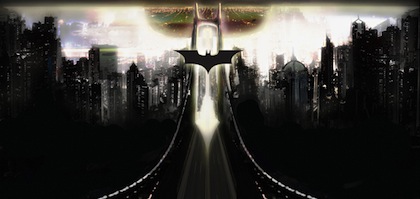
The City of Bruce Wayne and home to his people he must save. Wayne dwells in Gotham but the question often arises: is Wayne Manor even in Gotham? The guilt of Wayne’s beloved city is a central theme. It is Gotham that drives Batman out and choses the pharisaical murderer, Harvey Dent in his place : as Ms. Tate notes, “innocence is a strong word to throw around Gotham.” Nevertheless, Gotham remains worth saving to Batman even if he must give everything, even his life, to save it.
Bruce Wayne: The Eternal Logos, Second Person of the Blessed Trinity and Man
1) He possesses the wealth of his father and remains Gotham’s watchful and invisible ordering principle and protector.
2) Wayne also represents Man as such, viz. Prodigal Son, best exemplified in Dark Knight Rises when he separates from Alfred, the Father, and wakes up the next day to find himself penniless. This is also exhibited by Nolan in the first scenes Batman Begins when Wayne, as a child, falls while in the garden with the woman (young Rachael). In the end of Batman Begins, he and Rachael are restored to union in a new garden.
Batman
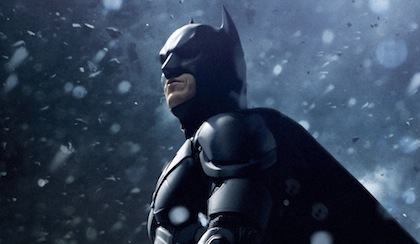
Jesus,The Incarnate Word. The man, condescends to join natures with a lower being, the Bat-Man, ie. the Man-God. He returns to save the city after 8 years (8th day being the day of resurrection). He gives everything to save Gotham and ultimately endows the city with his limitless wealth.
The Bat Symbol
The Cross, a sign of fear, must be lifted up to save the city.
Alfred: God The Father and Joseph

1) God the Father: A constant theme in The Dark Knight Rises is the will of Alfred for his beloved son, Bruce. It is Alfred who does not want to watch Wayne die but understands the mission at hand to save the people. Ultimately all that is Bruce Wayne’s is given to Alfred in addition to providing a home for the orphans. The final scene of the movie finds Wayne, his new bride in a new place, reunited with Alfred.
2) A Joseph Figure: Foster Father of the Son and the just man of old concerned with burying him.
Selina Kyle (Cat Woman): A Mary Figure.

1) Mary Magdelene: The harlot who is saved from attack by batman and reluctantly chooses to follow him rather than Bane. Wanting only “the clean slate,” she is also the first witness to the resurrection of Batman.
2) The Woman: Her turning point in the movie comes when she is eating a stolen APPLE, and then throws it away and agrees to follow Batman who is trusting her a second time. 3) Mary (the Church): First appearing as Wayne’s handmaiden, her weapon is in the sharp heel (cf. Genesis 3:15) and she is ultimately the one to crush the head of Bane. Before the ultimate saving plan is accomplished, Batman instructs her to stay with John and “be on the ground” while he is in the air. Ultimately, in the new land, she is also the new bride of Wayne, united to him under the delighted gaze of Alfred, the Father.
Bane: The Anti-Christ (the beast).
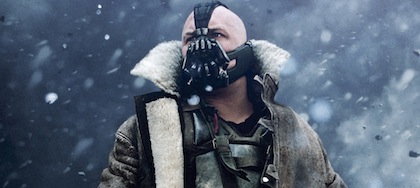
Appearing to Gotham as it’s savior, he bears the sign of Batman and offers poisoned hope to the people. An excommunicated member of the league, he comes preaching liberation and social justice, but his ultimate motive is the death of Batman and the ruin of the city. He is the rejected son of Ra’s al Ghul (Lucifer) and the one who props up Miranda Tate, the whore of Babylon. (cf. Revelation 17:3). He is the “strong man” who takes aways Batman’s armor (Luke 11:22). Those, such as Daggett, who seek to serve Bane are ultimately find themselves condemned in Jacobin fashion. He and Tate taunt Batman with the thought of making him watch the “fire of 12 million souls [he] failed.” With Ra’s al Ghul, and the Joker, Bane serves Nolan’s allegory as the third representation of evil, thus exemplifying the demonic parody of the Blessed Trinity.
Ra’s al Ghul: Lucifer.
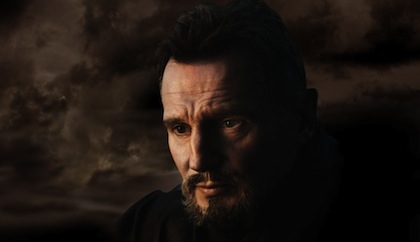
Bruce Wayne must undergo his trials to become Batman and save the city which is first accomplished by defeating him. “Ra’s al Ghul” is literally translated in Arabic as “the Demon’s head.” He is the Father of the whore of Babylon (Miranda Tate).
Miranda Tate (Talia al Ghul): The Whore of Babylon and The world.
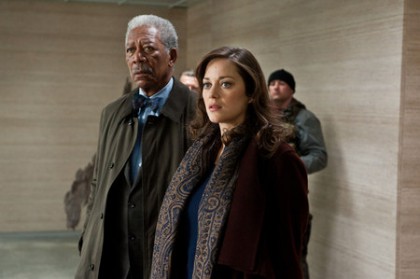
Under the guise of clean, unlimited energy, Miranda Tate explicitly wants to save the world and bring balance to it. Ultimately, she is found to be the Daughter of the Devil (Ra’s al Ghul), coming propped up on a beast, Bane, (Revelation 17:2) and will pierce the side of Batman and attempt to put Wayne’s city in fire for him to watch burn. The Whore also is said to fornicate with the kings (Wayne) of the earth (cf. Revelation 17). Wayne trusts her, knowing she will betray him. Upon her embrace of Wayne (the man), the light turns to darkness and Wayne expresses that he has ‘lost his power.‘ After sleeping with her, Wayne sees that she has the mark on her back.
John Blake aka Robin: John the Baptist and John the Beloved

1) The Baptist: John Blake is the first to recognize Batman as Bruce Wayne and herald his coming because ‘he knew him as a child.‘ He is irascible and upsets the hierarchy by pointing out their error and encourages the city to hope in Batman’s return.
2) The Beloved: The disciple that is favored over his superior (Peter Foley) and elevated to the status of detective. His sign is that of a bird and he stands before Batman’s ultimate sacrifice with Cat Woman. Unlike Peter Foley, who dies after his conversion in battle, John Blake remains alive. Ultimately, he will return to the cave, foster the orphans, and tell the story. Along with Selina Kyle (Mary), John Blake is the only character outside of Alfred and Fox (The First and Third Persons of the Blessed Trinity) to recognize that Batman is Wayne and follow him to the end of his mission.
The police: The Church and clergy.
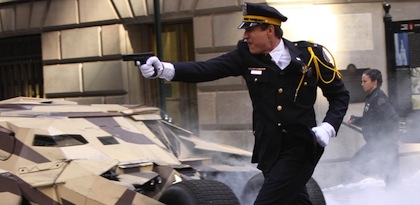
The three most prominent policeman in the Dark Knight Rises are named Peter Foley, Jim Gordon, and John Blake. Yes, Peter, James, and John. Here the allegory loosens especially with the character of Jim Gordon who throughout the trilogy is a Peter figure. The reader will remember in the Dark Knight, even Gordon, the trusty disciple of Batman, draws his weapon in protest of what Batman must do to defeat the Joker. In the Dark Knight Rises, Gordon first recognizes Batman when he is walking out onto the water (which is ice). Batman comes walking towards him over the water and commands him to light up the bat sign (the cross) to give the city hope of salvation. Gordon’s role in the salvation of Gotham is essential. He must go along for the final ride with Tate (the world) to disable the device of destruction and crash through the gates of the underworld as he leads the rest of the police force to assisting the Bat Man in his saving mission. His final profession of faith is to recognize that the pierced Batman, now ascending, is indeed Bruce Wayne.
The US Army: The Angels.
They are put at the opposite side of the bridge to prevent any man from passing to salvation before Batman has saved the city. They can deliver assistance and offer support to Gotham but ultimately must wait in hope for the saving plan of Batman to be accomplished. Bane’s first battle takes place against the army in the sky – then he is cast down.
Lucius Fox: The Holy Spirit

It is through the power of Mr. Fox that Bruce Wayne is incarnate as the Batman. His constant support offers Batman the tools he needs to defeat the enemy and he remains a trusty overseer of the board. He is sent to remain with Ms. Tate (the world) and notably exclaims in the film’s climax, the power of “a little air superiority.” The ‘Pentecost’ in the movie occurs when the police (Church) are noticeably timid and confused while marching into their battle mission. Unexpectedly, Fox’s vehicle, the Bat Wing drops from the sky and disables the enemy’s artillery. The inspired police then rush triumphantly into battle. Shout out, Filioque: Batman is propelling the Wing.
One last note about the Dark Night Rises: it is thoroughly eschatological. It is set in a time of seeming peace and security (1 Thes. 5) and for the fist time, Batman is seen fighting in the light of day for all to see (Matthew 24:27); his return is pre-figured by his sign appearing in the sky (Matthew 24:30) and his victory is made in a cloud of great glory (ibid.). It even takes place during winter (Matthew 24:20) and the final battle occurs after the righteous are resurrected from their tombs (1 Thes. 4:16).
Now I’m sure that we could watch The Dark Knight Rises a multitude of times and not exhaust the symbology – and I welcome you to do so and share your insight. Needless to say, the allegory is deliberate and overt. It takes many forms in each of Nolan’s films, but this is the most manifest example. And before the naysayers naysay, we will remind them that all allegory, as such, will fail at some point; no allegory is perfect, or it wouldn’t be an allegory. Nevertheless, it is advisable that Catholic should see this movie at least twice and take a page out of Nolan’s evangelization playbook. This IS the new evangelization: to respond to the crises of modernity and administer the Gospel in a mode that is potent and culturally receivable. One can google Nolan’s religious beliefs and find a striking lack of anything on his faith opinions – for now, he must wear the mask in order for the salvific ideas to be received by a sleepy and errant people. But as a Catholic, I would like to thank him for his very good work in the vineyard of the Lord. As the same people gobbled up a man named Jesus, not knowing he was God, and so were saved, so may this culture ingest the art of Christopher Nolan, not knowing it is indeed Sacred.

